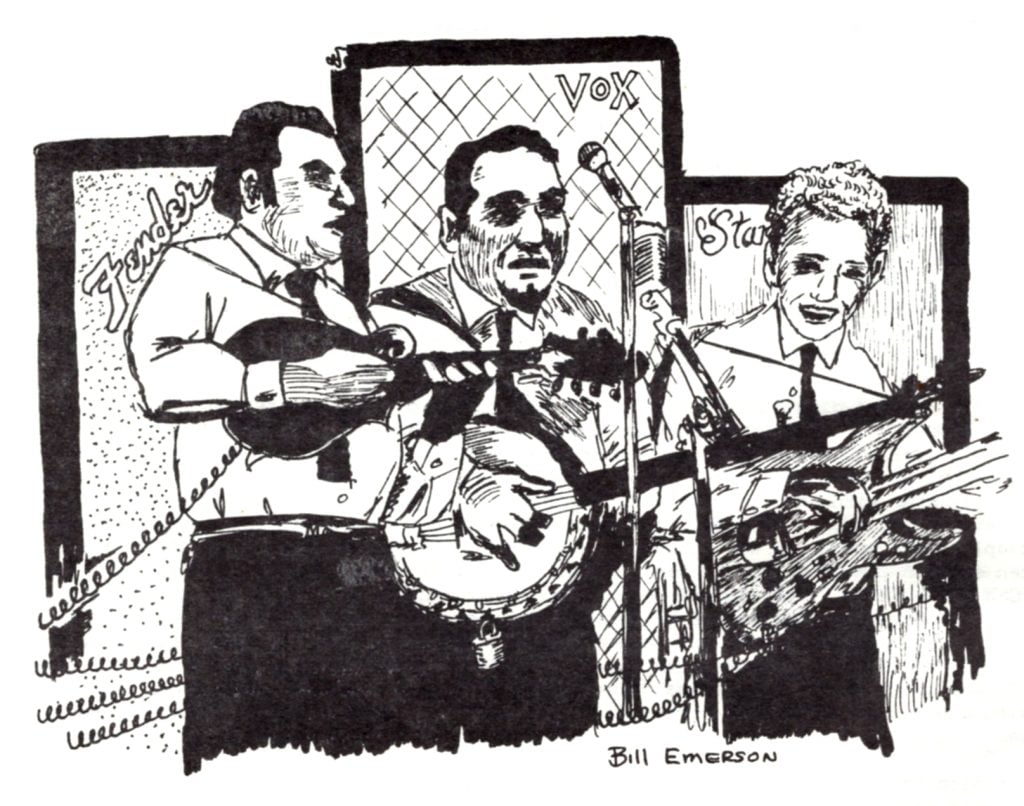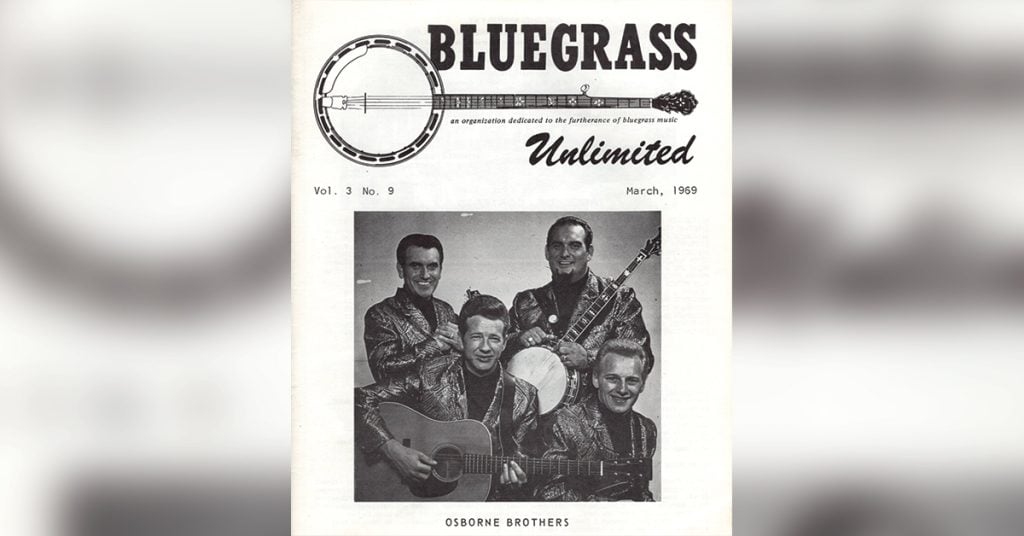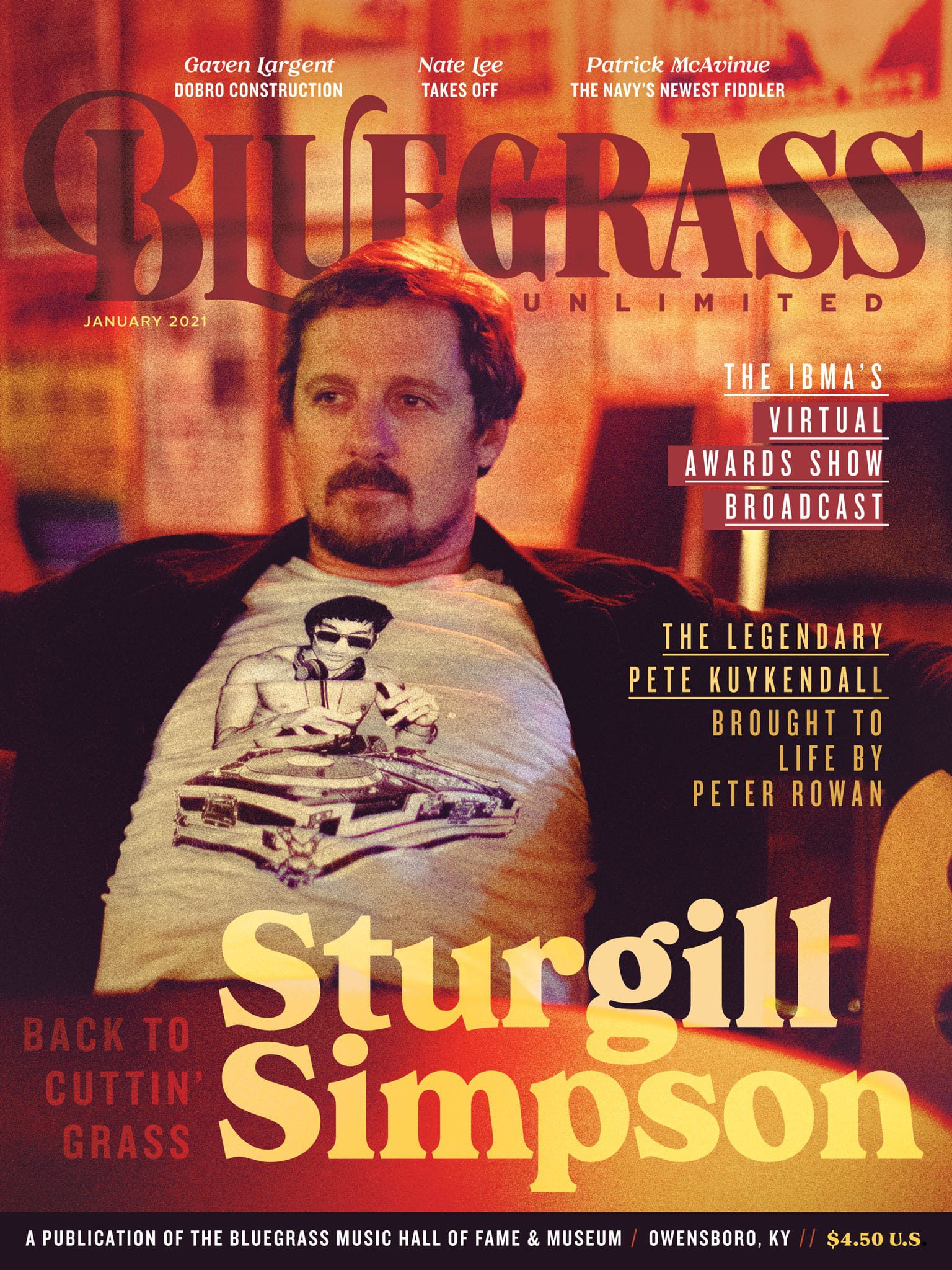Home > Articles > The Archives > Electric Bluegrass
Electric Bluegrass
Reprinted from Bluegrass Unlimited Magazine
March, 1969, Volume 3, Number 9
I was a witness to the Osborne Brothers recent debut in my area with all electric instruments. Sonny had a super secret pickup inside his banjo that no one was allowed to see. To make certain of this, he actually had his resonator attached with a pair of padlocks. Bob and Dale Sledd had pickups on and Ronnie Reno was equipped with a blue bass guitar. Frankly, it didn’t sound bad at all. The banjo and guitar sounded fairly normal. The mandolin was a little metallic, but it still sounded like a mandolin. The bass of course sounded like an electric bass. Apparently, there is more to it than just plugging in and they were having a little trouble getting the volume and tone controls set just right. When they finally got adjusted and got all their wires untangled, they sounded pretty good to me. I have a tape of this show and have listened to it many times. I must admit they sound different than before, but the power and dynamic force of the music is impressive, and it is definitely still bluegrass.
I suspect the secret pickup in the banjo is probably similar to the miniature transducers found in phonograph cartridges. Whatever it is, it works! Sonny told me that he believes the use of pickups which work (successfully) on banjos, guitars and mandolins will help bluegrass music. I know for a fact that it’s easier to play an electric instrument. You can hear yourself better and play lighter, which in turn makes you faster. It also eliminates string rattle and makes it possible to lower the string action for easier fingering. You can be heard at all times, be louder or softer, treble or bassy, simply by turning a knob.
Every time a banjo player steps in front of a microphone he is technically playing an electric banjo. His instrument is being electronically amplified to increase its volume. A public address system and electric guitar amplifier are almost identical in design and performance.
The difference is that the P.A. system has remote speakers and the guitar amp contains its components inside one enclosure. A guitar sounds better played through a mic than with a pickup on it because a microphone and magnetic guitar pickup perform in very different ways. Microphones will accurately reproduce the entire harmonic range of musical tones while magnetic pickups are not capable of reproducing anything more than the basic sound vibrations. This magnetic sound is rather metallic, run together and difficult to control. A good example of this sound is the electric banjo as played by Buck Trent of the Porter Wagoner band. Buck’s banjo sounds very much like a steel guitar. It is possible to obtain this sound merely by placing keys, strings and magnetic pickups on an ordinary two-by-four. Obviously, the culprit is not the amplifier, but the magnetic pickup.
While I was traveling with Jimmy Martin we participated in many country and western shows. More often than not these performances were carried out over an inadequate or malfunctioning public address system. We often had to follow such acts as Buck Owens or Hank Williams, Jr.
The P.A. was usually adjusted to suit the big stars who sing an inch or two away from the microphone, and don’t need to worry about the instruments being audible. In order to be effective, a bluegrass group must sing a foot or more away so that the sound of their instruments will also filter through. When we came on stage after Buck Owens we must have sounded very weak and at times we could barely hear each other. The advantages of electronic amplification in such situations are obvious.
I don’t see how the use of electric instruments can harm bluegrass music. Once upon a time all music was unamplified. When electric guitars were invented and integrated into jazz and blues music many felt it would ruin their music, but it hasn’t. Electric instruments have inspired many new kinds of music as well as improving the music we already had.

Bluegrass music as we know it has been exploited to the hilt, and what has been done before cannot be erased or damaged by progress. Up until now bluegrass music was usually performed by an unamplified string band. Vocals range from solo to quartet and the music is played and sung in its own distinctive timing. Rock, jazz, pop and most C&W is played to the down beat while bluegrass is played to the off-beat, like old-time fiddle music. The material has little to do with whether or not the music is bluegrass. Bill Monroe recorded songs like “Danny Boy” and “Four Walls,” but it was still bluegrass. This is because the songs were sung in bluegrass style with predominantly bluegrass instruments. The addition of an electric guitar or accordion makes no difference, it is definitely bluegrass. Jim and Jesse and Mac Wiseman have recorded with C&W accompaniment entirely and are now classified as C&W artists.
I believe that C&W music is bluegrass music’s worst enemy. When people think of bluegrass music going electric they immediately think in terms of it sounding like Buck Owens style electric hillbilly. I have learned that the same folk who enjoy country music don’t necessarily appreciate bluegrass and vice versa.
Country music people have always attempted to classify bluegrass music as the most primitive form of hillbilly music. Ironically, it is the other way around. Although they both evolved from early blues and folk music, bluegrass music and C&W bear little relationship to each other today. Bluegrass has practically become an art form. The same could hardly be said of C&W. I am afraid that bluegrass will continue to suffer as long as it is presented to the public in conjunction with country music. For example: 95% of the C&W radio stations refuse to program bluegrass because they feel it is non-commercial and distasteful to mass audiences.
The advertising end of the music business would like to amalgamate all types of music in order to jam it all down our throats at once. This is another good reason bluegrass music is having such a struggle to survive.
Artists like Mac Wiseman, Jim and Jesse and Flatt and Scruggs have helped keep it alive by conforming and have enjoyed some wealth and fame as a result. If these artists had not given in and gone semi-country and folk, the music would be fading even faster.
There are only two major companies producing bluegrass records today, Decca with Martin, Monroe and the Osborne Brothers, and Columbia with Flatt and Scruggs. All the other artists are hanging on with smaller subsidiaries, or little independent companies. Most of the small companies can’t get distributors to market their records, and stay in business by selling the artists their own records. How can bluegrass music be gaining in popularity when all the major companies were seriously trying to produce good grass in the 50s as compared with only two companies now?
I have heard several disc jockeys and promoters say that bluegrass fans won’t come out to support the music. This doesn’t include things like the Berryville Extravaganza which only comes once a year and has practically every name in the business. What they’re talking about is local support. When a bluegrass group plays to a non-grass audience, it is very difficult to entertain them with hard grass. It’s just not the kind of music they want to hear. They request everything from “Hound Dog” to “Stardust” and don’t like it if you can’t play them.
Many people don’t even know what bluegrass music is. Bluegrass entertainers have learned that they can sell to the other 80% of the audience if they sing C&W or Rock and Roll. Of course, going C&W like Jim and Jesse is not the answer. That would only combine bluegrass with C&W and then we’d have only C&W and no bluegrass. I think the answer is to be found with fresh new material done in a tasteful and understandable way. Even the bluegrass fans are weary of “Salty Dog” and “Little Cabin Home on the Hill.” This is classic bluegrass music and no one loves it any more than I; but it has been done, and it’s over with. A repeat of the same old song with a new tune or a different verse is like whipping a dead horse. What we need is some talented song writers and clever arrangers.
In my opinion the Country Gentlemen have done a great deal to improve the music, and their performances are the proof. They have recorded much new material in their own style, yet they have managed to retain the basic bluegrass flavor. Best of all their music is up to date and understandable. I also think the Osborne Brothers have contributed much along those lines. Their strong influence will very likely bring electric instruments into bluegrass music.
In sum: I believe that electric instruments combined with up to date material can help bluegrass come into its own as a separate style of music. If this is possible, I am highly optimistic about the future of our music. The fact that music in general is such a vital part of our lives today means that people will continue as active and searching listeners for many generations to come. The more they listen, the more types of music they will support. New forms of music with new names will emerge in the future just as they have in the past. We are at the beginning of a musical renaissance and will be able to look back on these times as a period when music became available to us all in an unprecedented amount and variety. Hopefully bluegrass music will come to be recognized as a separate and important form of American music during these times.
Even though you may disagree with my humble opinions within this article, I am interested in your opinions and welcome your comments.

